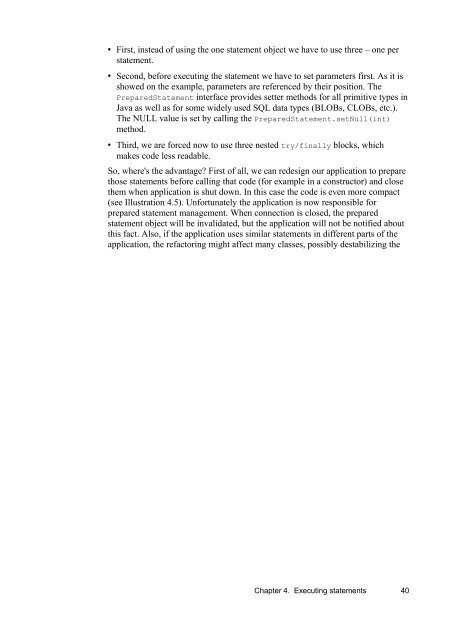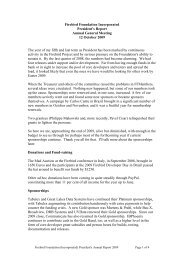Jaybird 2.1 JDBC driver Java Programmer's Manual - Firebird
Jaybird 2.1 JDBC driver Java Programmer's Manual - Firebird
Jaybird 2.1 JDBC driver Java Programmer's Manual - Firebird
Create successful ePaper yourself
Turn your PDF publications into a flip-book with our unique Google optimized e-Paper software.
• First, instead of using the one statement object we have to use three – one per<br />
statement.<br />
• Second, before executing the statement we have to set parameters first. As it is<br />
showed on the example, parameters are referenced by their position. The<br />
PreparedStatement interface provides setter methods for all primitive types in<br />
<strong>Java</strong> as well as for some widely used SQL data types (BLOBs, CLOBs, etc.).<br />
The NULL value is set by calling the PreparedStatement.setNull(int)<br />
method.<br />
• Third, we are forced now to use three nested try/finally blocks, which<br />
makes code less readable.<br />
So, where's the advantage? First of all, we can redesign our application to prepare<br />
those statements before calling that code (for example in a constructor) and close<br />
them when application is shut down. In this case the code is even more compact<br />
(see Illustration 4.5). Unfortunately the application is now responsible for<br />
prepared statement management. When connection is closed, the prepared<br />
statement object will be invalidated, but the application will not be notified about<br />
this fact. Also, if the application uses similar statements in different parts of the<br />
application, the refactoring might affect many classes, possibly destabilizing the<br />
Chapter 4. Executing statements 40
















